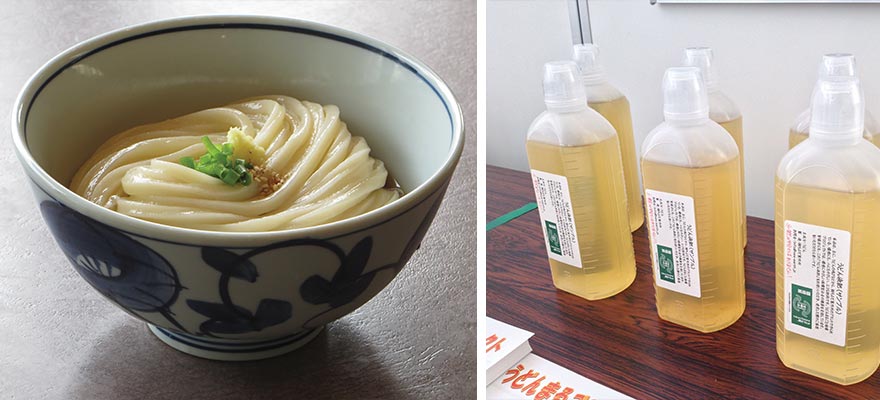Home > Highlighting JAPAN >Highlighting Japan June 2014>Revitalizing Japan's Regions
Highlighting JAPAN
Revitalizing Japan's Regions
Udon Total Recycling Project
Powering an environmental program with local products

Kagawa Prefecture is so renowned for its udon noodles that it calls itself "the Udon Prefecture." Several years ago a local revitalization project found great success marketing udon, and many people from all over Japan came to Kagawa Prefecture to enjoy its noodles.
Now they not only eat udon in Kagawa, they've started recycling it. Kagawa's groundbreaking recycling system, which functions at a level where absolutely no udon is wasted, is drawing attention as a model for future food waste processing. We spoke about the project with Chiyoda Manufacturing CEO Eiji Iketsu, who single-handedly undertook the development of the hardware portion of what came to be known as the "Udon Total Recycling Project," and Tomio Sumada, president of the Udon Total Recycling Consortium.
"Before we started this project, the issue of disposable chopsticks came to our attention," Sumada says. "The chopsticks customers used in udon shops were all thrown away. An initiative was launched to collect the chopsticks and recycle them into wood pulp. Through that initiative, it came to light that there was also a large quantity of udon being thrown away."
To give an example, one company in Kagawa Prefecture that manufactures a great deal of frozen udon was disposing of approximately fifteen hundred tons of noodles per year at peak production, primarily because of defects in production. Under the recycling project, discarded udon is shredded and combined with enzymes, yeast and water to produce ethanol.
According to Iketsu and Sumada, there have been many attempts all over Japan to extract ethanol from various raw materials, but the amount collected has been small, so when factoring in labor and equipment costs it is rather difficult to continue. Udon is a starch, however, so it has the advantages of simple fermentation and the equipment needed being inexpensive. The ethanol extracted can then be used to boil udon.
The dregs remaining after ethanol extraction don't go to waste; they are processed in methane fermentation equipment to create methane gas. The methane gas is used as boiler fuel to keep the temperature of the aforementioned ethanol fermentation equipment stable.
"Even after we extract the ethanol and methane gas, we still have some dregs left over. These are made into liquid organic fertilizer using specialized equipment, and the fertilizer is scattered over the fields that grow the wheat used to produce the udon and the green onions eaten with the udon. Liquid fertilizer is bulky and difficult to store, so we're currently perfecting a process that will use special technology to make it solid."
Under this recycling system, nothing goes to waste. Sumada and Iketsu are eager to expand the program to food waste disposal in general.
"It's a paradigm shift: to go from using energy to dispose of waste to harvesting energy from waste. We're convinced that this system will play a useful role in ensuring a stable energy supply, but at present, when we consider the cost and risk involved in businesses starting these initiatives individually, there's a high threshold to overcome. We've been able to make it this far because of the cooperation we've gotten from the prefecture and the city. We believe that it's necessary to undertake this balancing act of gaining administrative support on both the soft and hard fronts, fostering business support, and changing popular attitudes to create an eco-friendly society that recycles its energy."
It is hoped that Kagawa's environmental program, which makes exhaustive use of local resources, will be promoted throughout Japan as an example of a cutting-edge success.
© 2009 Cabinet Office, Government of Japan






